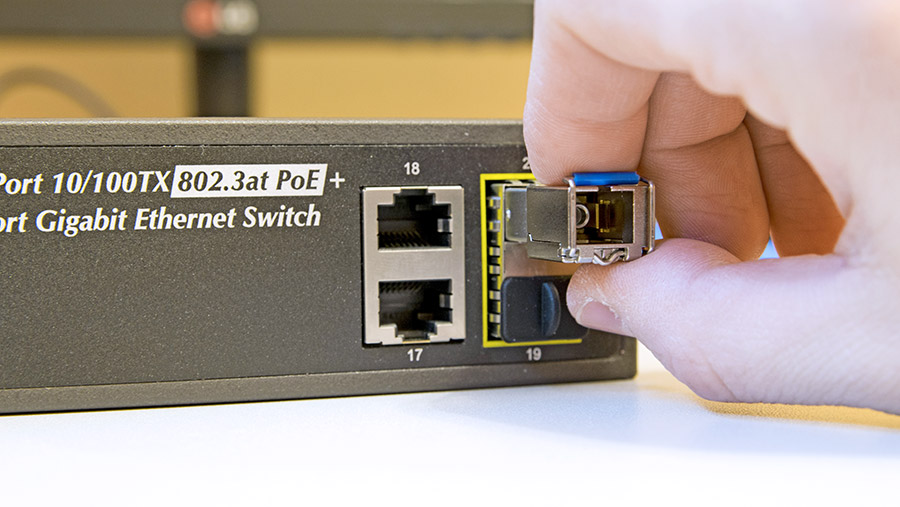

 Knowledge Base +
Knowledge Base +  2023.12.08
2023.12.08No, a 10G SFP module cannot be directly used for a 1G connection. The SFP module and the port it is connected to must support the same data rate. However, there are some switches and routers that have SFP+ ports which are backward compatible with 1G SFP modules. In such cases, a 10G SFP module can be used for a 1G connection by configuring the SFP+ port to operate at the lower data rate.
1G SFP Port on Gigabit Switch Cannot Take 10Gb SFP+ Optics on 10Gb Switch in All Cases
Will 10Gb SFP+ running at 1Gb? The answer is definitely “No” SFP optics do work in SFP+ slots in most cases, but SFP+ optics on 10Gb switch can never work in SFP slots on gigabit switch. The reason is about a power availability thing. As we know, once an module is installed, the speed of the port is decided. Most SFP+ slots are backward compatible with SFP modules to run at 1G speed. However, the SFP slots on gigabit switch cannot support the 10G speed required by SFP+ modules. For instance, most Cisco and FS 10Gb switches support 10G SFP+ and 1G SFP optics on their SFP+ ports. But some Brocade gear and HP A-series models are SFP+ only. One need to double check the compatibility of this switch with the vendor rep.

What is an SFP port?
An SFP port is a slot on a network device or computer into which small form-factor pluggable (SFP) transceivers are inserted.

An SFP transceiver, also known as an SFP module, is just a hot-swappable, pinky-sized metal component that, when connected to another device using a cable, allows for the transmission of data.
What is an SFP Transceiver Modules
An SFP, Small form-factor pluggable, is a compact and hot-swappable transceiver used to connect a switch or other network device to copper or fiber cable. SFP replaces the formerly common gigabit interface converter (GBIC), and SFP is also called Mini-GBIC. The SFP ports on a switch and SFP modules enable the switch to connect to fiber and Ethernet cables of different types and speeds. The small formfactor pluggable, SFP, specification is based on IEEE802.3 and SFF-8472. Almost all enterprise-class switches include two or more SFP ports, enabling them to become part of a ring- or star-based network topology spread among different buildings, floors or areas, connected via fiber optic cabling.
How does an SFP port work?
An SFP port connection enables the transfer of data between two devices via an SFP transceiver and appropriate cabling. In other words, the port and its corresponding SFP transceiver allow the two devices to communicate with each other over an extended distance.
What is an SFP port used for?
SFP ports and their corresponding SFP modules are used to facilitate seamless, high-speed data communications or telecommunications connections over extended distances in a variety of applications. They鈥檙e often used to connect a one-gigabit network switch to another, which, in turn, increases the size and improves the functionality of a network. This is helpful in military, industrial, and commercial settings where numerous devices in a widespread area require a wired, high-speed, reliable connection.
How to Choose an Ethernet SFP Module?
Choose SFP Copper or Fiber Module?
SFP module comes in various types on the basis of different classification standards. It works with copper Ethernet cables or fiber optical cables.
On the fiber optics side, there are single mode SFP module and multimode SFP module, which allows users to select the appropriate transceiver according to the required optical range for the network. Operation wavelength ranges from 850nm to 1550nm. Commonly, 850nm SFP can reach up to 550 meters with multimode fiber optics, and the 1550nm SFP supports up to a maximum of 160km via single mode fiber cables. On the other hand, copper SFP modules primarily are 1000BASE-T SFP and 1000BASE-TX SFP modules, which are excellent used in gigabit Ethernet networking within 100 meters.
Choose SFP or Advanced SFP+?
SFP and SFP+ are applied at different transmission speeds. SFP module supports 1Gb data rate, and the SFP type includes 1000base-T/TX, 1000base-SX, 1000base-LX/LX10, 1000base-BX10, 1000base-LX/LH, 1000base-EX, 1000base-ZX and so on.
SFP+ is used in 10-gigabit Ethernet applications but shares the same form factor with SFP. In the SFP+ family, there are primarily SFP+ SR, SFP+ LR, and SFP+ ZR modules for 10 Gigabit ethernet networking.
Choose an MSA Compatible SFP or Not?
Compatibility is often the most important parameter users care about when buying an MSA SFP module. MSA (multi-source agreement) is an agreement supported by a number of manufacturers who came together to collaborate and standardize the fit-form and try to provide a reliable mean of mixing and matching SFP brands successfully. Third-party companies also have developed their own tools to program SFP modules to be compatible with the OEM. So, the MSA compatibility Gigabit SFP module can be used successfully in most networks.
SFP vs. SFP+
Here is a table of comparison between SFP and SFP+
Item | SFP | SFP+ |
Stands for | Small Form-factor Pluggable | Small Form-factor Pluggable plus (standard form) |
Data rate | 155M/622M/ 1.25G/ 2.5G/3G/ 4.25G | 6G/8.5G/10G |
Terms | Dual fiber Single Fiber/WDM CWDM DWDM | Dual fiber Single Fiber/WDM CWDM DWDM |
Distance | 300m/2km/ 10km/15km/ 20km/40km/ 60km/80km/ 100km/120km/ 150km | 220m/300m/ 2km/10km/ 20km/40km/ 60km/80km |
Wavelengths | 850nm/1310nm/1550nm 1310nm/1490nm/1550nm 1270nm-1610nm ITU17~ITU61 | 220m/300m/ 2km/10km/ 20km/40km/ 60km/80km/ 120km |
Subscribe to the newsletter
for all the latest updates.
2-5# Building, Tongfuyu Industrial Zone, Aiqun Road, Shiyan Street, Baoan District, Shenzhen. China
